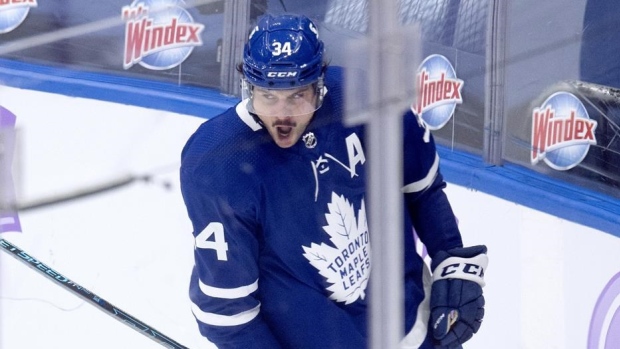Nov 17, 2021
Underlying numbers point to a Matthews scoring surge
The Maple Leafs star isn’t exactly off to a poor start this season, but the numbers point to a player on the verge of an offensive explosion, Travis Yost writes.
By Travis Yost

Is Auston Matthews ready to take off?
It’s amusing to theorize about a breakout to the upside for a player who is already scoring at a point-per-game pace (seven goals and seven assists in 14 games), but Matthews is unique.
We are talking about a star centre whose career average is well above the point-per-game threshold, and, more specifically, a player who has averaged about 0.6 goals per game over that span. He is not far removed from off-season wrist surgery but returned to the Maple Leafs lineup on Oct. 18.
It’s been curious watching the Maple Leafs this season, and Matthews’ line in particular. The power play has been dynamic (9.3 goals per 60 minutes; seventh in the NHL), but the scoring at even strength has been lacklustre. Through Wednesday, only six teams were less effective than Toronto at finding the back of the net there.
The early theory has been a lack of puck luck, so to speak, has neutralized the Toronto attack. The Maple Leafs are shooting 6.7 per cent as a group at even strength, despite generating more scoring chances than any other team in the league. At some point, heavy shooting volumes – where much of those shots are coming from the low slot and the interior – are going to win out.
Bringing this back to Matthews for a moment, he has just three goals at even strength this year and his line is converting on just 7 per cent of their shots. He’s played all his minutes with some combination of William Nylander, Michael Bunting, and Mitch Marner on the wings, plus a heavy dose of the Morgan Rielly pairing behind him.
As a group, they are dominating their opponents – something to the tune of 63 per cent expected goals and 58 per cent of the shots to the favour of Toronto. But because of the poor shooting performances, the goal differentials (+2) are underwhelming.
If we look at the offensive end of the ice, we notice three things.
First, the shot profile with Matthews on the ice is blistering in the offensive zone, with heavy pressure being applied from between the circles (via HockeyViz):

Second, that Matthews individually is generating heavy (and sustained) volumes of scoring chances, as he has done throughout his career. The goal scoring stretches that ebb and flow over the course of his regular season have only been in one direction this season, which is quite unique:

Third, look at Matthews’ own shooting baselines, with the added context that (a) the players and environment around him have not changed; (b) there isn’t an age concern; (c) the rest of Toronto’s stats are right in line with expectations and prior seasons.

These are the hallmark signs of a player who is going to see favourable regression in short order. Think of the components we have already quantified that should be tailwinds for Matthews’ offensive recovery:
- He is near a career low in shooting percentage
- He is at a career high in individual shot generation
- His line is generating career-high shot volumes and scoring chances
- His line is conceding about the same amount of scoring chances and shots as last year, indicative of little relative time spent in the defensive zone
- He is playing more than 20 minutes a night, and generally with the same players who have been around during previous scoring outbursts
Matthews isn’t off to a poor start, but he is off to a slow one relative to our expectations – transitioning from one of the best goal scorers in the world to being tied for 79th and trailing the likes of Buffalo’s Tage Thompson and Calgary’s Milan Lucic is a bit of unchartered territory for the 24-year old.
The good news for Toronto fans, and the bad news for everyone else? All things remaining equal, Matthews looks primed for an offensive explosion.
Data via Natural Stat Trick, NHL.com, Evolving Hockey, HockeyViz

